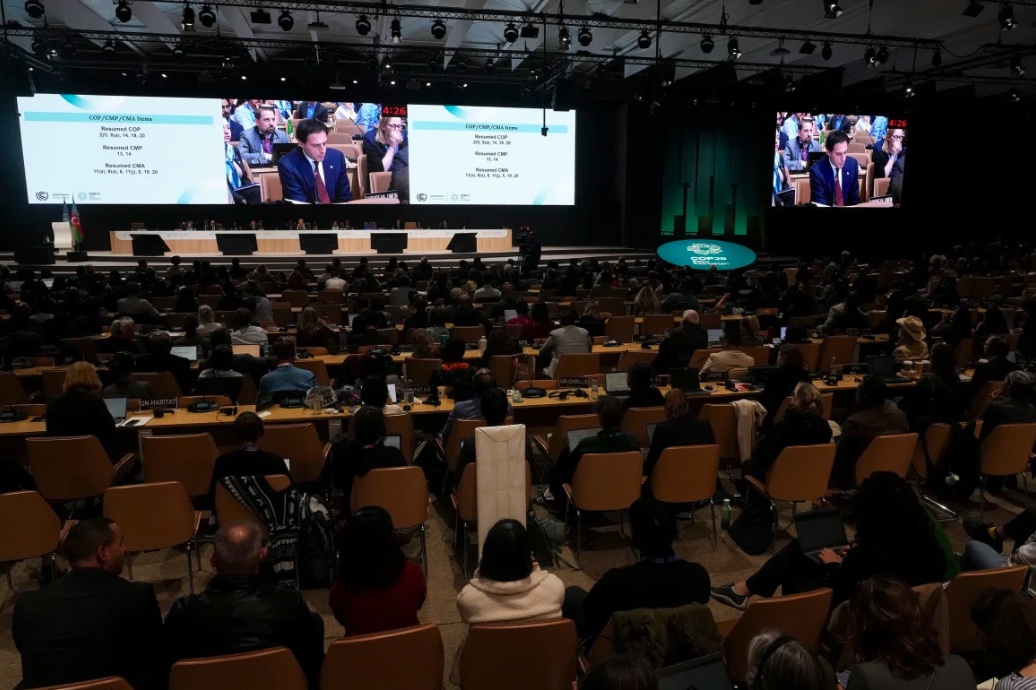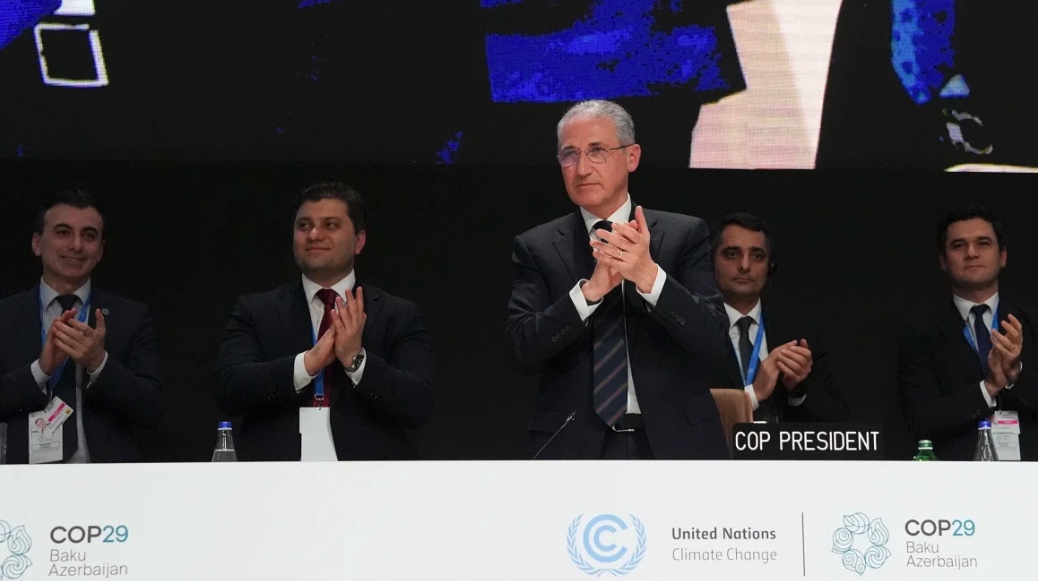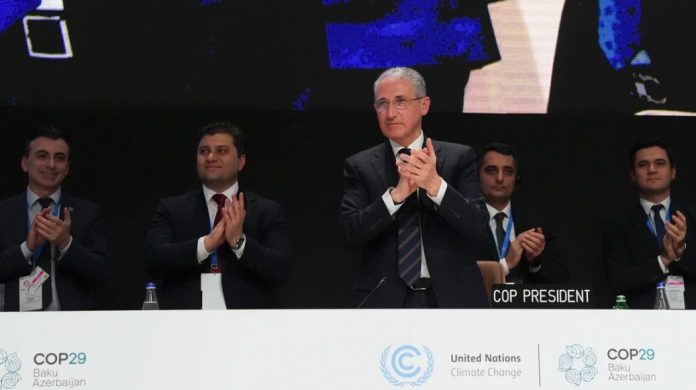โลกได้บรรลุข้อตกลงด้านสภาพภูมิอากาศฉบับใหม่ในที่ประชุม COP29 ที่บากู ประเทศอาเซอร์ไบจาน เมื่อวันเสาร์ที่ผ่านมา โดยประเทศร่ำรวยได้ให้คำมั่นที่จะจัดสรรเงินช่วยเหลือ 300 พันล้านดอลลาร์ต่อปีภายในปี 2035 เพื่อช่วยประเทศยากจนรับมือกับผลกระทบอันร้ายแรงจากวิกฤตสภาพภูมิอากาศ อย่างไรก็ตาม ตัวเลขดังกล่าวถูกวิจารณ์จากหลายประเทศกำลังพัฒนาว่ายังต่ำเกินไปอย่างมาก
ข้อตกลงนี้เกิดขึ้นหลังการเจรจาที่เต็มไปด้วยความขัดแย้งและการแบ่งฝักแบ่งฝ่ายซึ่งยืดเยื้อนานกว่าสองสัปดาห์ โดยในบางช่วงของการประชุม กลุ่มประเทศหมู่เกาะเล็กและประเทศที่พัฒนาน้อยที่สุดได้ถอนตัวจากการเจรจา อย่างไรก็ตาม เมื่อเวลา 02.40 น. ตามเวลาท้องถิ่นของวันอาทิตย์ หลังจากที่เลยกำหนดการไปกว่า 30 ชั่วโมง ข้อตกลงระหว่างประเทศเกือบ 200 ประเทศก็ได้ข้อสรุปในที่สุด
“มีคนเคยสงสัยว่าอาเซอร์ไบจานจะทำให้สำเร็จได้หรือไม่ หรือว่าทุกประเทศจะสามารถตกลงร่วมกันได้ แต่พวกเขาคิดผิดทั้งสองเรื่อง” มุคห์ตาร์ บาบาเยฟ ประธาน COP29 และอดีตผู้บริหารบริษัทน้ำมันของรัฐอาเซอร์ไบจาน กล่าว
เงินจำนวน 300 พันล้านดอลลาร์นี้จะถูกจัดสรรให้กับประเทศยากจนและเปราะบางเพื่อช่วยพวกเขารับมือกับสภาพอากาศสุดขั้วที่รุนแรงขึ้นเรื่อย ๆ และปรับเปลี่ยนเศรษฐกิจของพวกเขาให้เป็นมิตรกับพลังงานสะอาดมากขึ้น
“มันเป็นเส้นทางที่ยากลำบาก แต่เราก็ได้ข้อตกลงแล้ว” ไซมอน สตีล หัวหน้าสำนักเลขาธิการกรอบอนุสัญญาสหประชาชาติว่าด้วยการเปลี่ยนแปลงสภาพภูมิอากาศ (UNFCCC) กล่าว “เป้าหมายการเงินใหม่นี้คือหลักประกันสำหรับมนุษยชาติ ท่ามกลางผลกระทบด้านสภาพอากาศที่รุนแรงขึ้นในทุกประเทศ”
อย่างไรก็ตาม เงินจำนวนดังกล่าวยังต่ำกว่าที่นักเศรษฐศาสตร์ระบุว่าโลกจำเป็นต้องใช้ถึง 1.3 ล้านล้านดอลลาร์ เพื่อช่วยประเทศกำลังพัฒนารับมือกับวิกฤตสภาพภูมิอากาศที่พวกเขาไม่ได้เป็นผู้ก่อหลัก และทำให้เกิดเสียงวิพากษ์วิจารณ์อย่างรุนแรงจากหลายประเทศกำลังพัฒนา
ในคำปราศรัยที่ร้อนแรงหลังข้อตกลงได้รับการอนุมัติ ผู้แทนจากอินเดีย ชัณฑนี ไรนา ได้ประณามจำนวนเงิน 300 พันล้านดอลลาร์ว่า “ต่ำเกินจะรับได้” และเป็นเพียง “ภาพลวงตา” ที่ไม่สามารถแก้ปัญหาขนาดใหญ่ที่เราทุกคนเผชิญได้
คนอื่น ๆ ก็ออกมาวิพากษ์ในลักษณะเดียวกัน
“สิ่งที่เราได้รับนั้นยังไม่เพียงพอต่อความต้องการเร่งด่วนของประเทศที่เปราะบางต่อสภาพภูมิอากาศ” ทินา สเตจ ทูตพิเศษด้านสภาพภูมิอากาศของหมู่เกาะมาร์แชลล์ กล่าว
สเตจยังวิจารณ์การประชุมว่าแสดงให้เห็นถึง “การฉวยโอกาสทางการเมืองในรูปแบบที่เลวร้ายที่สุด” โดยระบุว่าผลประโยชน์จากเชื้อเพลิงฟอสซิลได้ “พยายามขัดขวางความก้าวหน้าและบ่อนทำลายเป้าหมายพหุภาคีที่เราสร้างขึ้น”
เนื้อหาในข้อตกลง
การประชุม COP29 มุ่งเน้นไปที่เรื่องการเงิน ซึ่งเป็นประเด็นสำคัญแต่ยังเต็มไปด้วยความอ่อนไหวทางการเมือง
ประเทศร่ำรวยที่มีส่วนรับผิดชอบต่อการเปลี่ยนแปลงสภาพภูมิอากาศในอดีต ตกลงในปี 2009 ที่จะให้เงินช่วยเหลือปีละ 100 พันล้านดอลลาร์แก่ประเทศกำลังพัฒนาภายในปี 2020 ซึ่งเงินจำนวนดังกล่าวถูกมองว่ายังน้อยเกินไป และล่าช้ากว่ากำหนดถึงสองปี โดยเพิ่งบรรลุเป้าหมายนี้ในปี 2022
งานของที่ประชุมที่บากูครั้งนี้ คือการกำหนดตัวเลขใหม่
ข้อตกลงใหม่นี้กำหนดให้ประเทศร่ำรวย รวมถึงสหรัฐอเมริกาและประเทศในยุโรป ต้องจัดสรรเงิน 300 พันล้านดอลลาร์ทุกปีจนถึงปี 2035 โดยเงินจำนวนนี้จะมาจากการเงินทั้งภาครัฐและเอกชน
แม้ข้อตกลงจะกล่าวถึงความทะเยอทะยานในการเพิ่มเป้าหมายเป็น 1.3 ล้านล้านดอลลาร์ แต่ประเทศกำลังพัฒนาต้องการให้ประเทศร่ำรวยรับผิดชอบในสัดส่วนที่มากขึ้น และให้เงินช่วยเหลือมาในรูปแบบของเงินสนับสนุน (grants) มากกว่าการให้กู้ยืม (loans) ที่อาจทำให้ประเทศเหล่านี้ต้องเผชิญกับหนี้สินเพิ่มขึ้น

กลุ่ม G77 ซึ่งประกอบด้วยประเทศกำลังพัฒนา ได้เรียกร้องเงินช่วยเหลือที่ 500 พันล้านดอลลาร์ แต่ประเทศร่ำรวยมองว่าตัวเลขที่สูงกว่านี้ “เป็นไปไม่ได้ในทางการเมือง” ท่ามกลางสภาพเศรษฐกิจปัจจุบัน
นอกจากนี้ ยังมีการผลักดันให้ประเทศเศรษฐกิจร่ำรวยที่ยังเป็นประเทศกำลังพัฒนา เช่น จีนและซาอุดีอาระเบีย มีส่วนร่วมในการจัดหาเงินทุน แต่ข้อตกลงฉบับนี้กลับระบุเพียงว่า “สนับสนุน” ให้ประเทศกำลังพัฒนาเหล่านี้มีส่วนร่วมโดยสมัครใจ โดยไม่มีข้อผูกพันใด ๆ
หลี่ ชั่ว ผู้อำนวยการ China Climate Hub ของ Asia Society Policy Institute กล่าวว่า ข้อตกลงนี้คือ “การประนีประนอมที่มีข้อบกพร่อง” สะท้อนถึง “สภาพภูมิศาสตร์การเมืองที่ยากลำบากขึ้นในปัจจุบัน”
การประชุมที่เต็มไปด้วยความวุ่นวาย
การประชุมครั้งนี้เกิดขึ้นในช่วงสิ้นปี ซึ่งเกือบจะแน่นอนว่าเป็นปีที่ร้อนที่สุดเป็นประวัติการณ์ โดยทั่วโลกต้องเผชิญกับสภาพอากาศสุดขั้ว ตั้งแต่พายุเฮอร์ริเคนที่เกิดขึ้นต่อเนื่อง น้ำท่วมใหญ่ พายุไต้ฝุ่นที่สร้างความเสียหายอย่างหนัก และภัยแล้งรุนแรงในแอฟริกาใต้
แม้ความเร่งด่วนในการจัดการวิกฤตสภาพภูมิอากาศจะชัดเจนกว่าที่เคย แต่ COP ครั้งนี้ก็ยังเต็มไปด้วยความท้าทาย
การประชุมจัดขึ้นที่อาเซอร์ไบจาน ประเทศที่ยังพึ่งพาอุตสาหกรรมน้ำมัน และเต็มไปด้วยผู้มีส่วนได้ส่วนเสียในเชื้อเพลิงฟอสซิล โดยมีผู้ลงทะเบียนเข้าร่วมจากอุตสาหกรรมนี้กว่า 1,700 คน ซึ่งมากกว่าจำนวนผู้แทนของหลายประเทศรวมกัน จากการวิเคราะห์ของกลุ่ม Kick Big Polluters Out
นอกจากนี้ การเลือกตั้งโดนัลด์ ทรัมป์ในสหรัฐฯ ก็เป็นเงาที่ปกคลุมการประชุมครั้งนี้ ทรัมป์เคยกล่าวว่าวิกฤตสภาพภูมิอากาศเป็นเรื่องหลอกลวง และเคยให้คำมั่นว่าจะถอนสหรัฐฯ ออกจากข้อตกลงปารีส ซึ่งสร้างความกังวลต่ออนาคตของความร่วมมือระหว่างประเทศในเรื่องสภาพภูมิอากาศ
ซาอุดีอาระเบีย ผู้ส่งออกน้ำมันรายใหญ่ที่สุดของโลก ซึ่งเคยต่อต้านมาตรการที่ทะเยอทะยานในการประชุมครั้งก่อน ดูเหมือนจะมีความมั่นใจมากขึ้นในการประชุมที่บากู โดยปฏิเสธอย่างชัดเจนต่อการกล่าวถึงน้ำมัน ถ่านหิน และก๊าซในข้อตกลง
“นี่เป็นอีกครั้งของ COP ที่มีรอยเปื้อนน้ำมันและความลับดำมืด” ฟริเดอริเก อ็อตโต นักวิทยาศาสตร์ด้านภูมิอากาศจากวิทยาลัยอิมพีเรียลลอนดอนกล่าว “ความสนใจจากสาธารณชนต่อ COP ครั้งนี้ต่ำมาก และความรู้สึกถากถางดูเหมือนจะพุ่งสูงสุดเท่าที่เคยมีมา”
หลายกลุ่มเคลื่อนไหวด้านสภาพภูมิอากาศได้ออกมาวิจารณ์ที่ประชุมและผลลัพธ์ที่ได้อย่างหนักหน่วง
“นี่เป็นการเจรจาด้านภูมิอากาศที่เลวร้ายที่สุดในรอบหลายปี เนื่องจากความไม่จริงใจของประเทศพัฒนาแล้ว” ทัสนีม เอสซอป ผู้อำนวยการบริหารของ Climate Action Network กล่าว “ที่ประชุมนี้ควรเป็น COP ด้านการเงิน แต่กลุ่มประเทศทางเหนือกลับมาพร้อมแผนการทรยศต่อกลุ่มประเทศทางใต้”
ผลลัพธ์นี้ “เป็นความหวังลวงตาสำหรับผู้ที่ต้องเผชิญกับผลกระทบของภัยพิบัติทางสภาพภูมิอากาศอยู่แล้ว” ฮาร์จีต ซิงห์ จาก Fossil Fuel Treaty Initiative กล่าว “เราต้องสู้ต่อไป เรียกร้องการเพิ่มการเงินอย่างมีนัยสำคัญ และยืนหยัดให้ประเทศพัฒนาแล้วต้องรับผิดชอบต่อไป” เขากล่าวเสริม
World agrees to climate deal on financial aid for developing countries after summit nearly implodes

The world agreed to a new climate deal at COP29 in Baku, Azerbaijan, Saturday, with wealthy countries pledging to provide $300 billion annually by 2035 to poorer countries to help them cope with the increasingly catastrophic impacts of the climate crisis — a figure many developing countries criticized as vastly insufficient.
The agreement came after more than two weeks of bitter divisions and fractious negotiations, thrown into chaos by boycotts, political spats and open celebrations of fossil fuels.
At points there was fear the talks would implode, as groups representing vulnerable small island states and the least-developed countries walked out of negotiations Saturday. But at 2:40 a.m. local time Sunday, more than 30 hours after deadline, the gavel finally went down on the agreement between nearly 200 countries.
“People doubted that Azerbaijan could deliver. They doubted that everyone could agree. They were wrong on both,” said Mukhtar Babayev, the Azerbaijani state-oil company veteran and president of COP29.
The $300 billion will go to vulnerable, poorer nations to help them cope with increasingly devastating extreme weather and to transition their economies toward clean energy.
“It has been a difficult journey, but we’ve delivered a deal,” said Simon Stiell, head of the United Nations Framework Convention on Climate Change. “This new finance goal is an insurance policy for humanity, amid worsening climate impacts hitting every country.”
The amount pledged, however, falls far short of the $1.3 trillion economists say is needed to help developing countries cope with a climate crisis they have done least to cause — and there has been a furious reaction from many developing countries.
In a fiery speech immediately after the gavel went down, India’s representative Chandni Raina slammed the $300 billion as “abysmally poor” and a “paltry sum,” calling the agreement “nothing more than an optical illusion” and unable to “address the enormity of the challenge we all face.”
Others were equally damning in their criticism.
“We are leaving with a small portion of the funding climate-vulnerable countries urgently need,” said Tina Stege, Marshall Islands climate envoy.
Stege heavily criticized the talks as showing the “very worst of political opportunism.” Fossil fuel interests “have been determined to block progress and undermine the multilateral goals we’ve worked to build,” she said in a statement.
What the deal sets out
COP29 focused heavily on finance, a vital climate issue but one of the thorniest politically.
Rich countries, which are overwhelmingly responsible for historical climate change, agreed in 2009 to provide $100 billion a year by 2020 to developing countries. That pledge, already viewed as woefully insufficient, was only met in 2022, two years past the deadline.
The task at Baku was to come up with a new number.
The new deal agreed to on Saturday requires wealthy countries, including the US and European nations, to provide $300 billion every year by 2035, made up of public and private finance.
While the agreement also refers to a wider ambition to scale up to $1.3 trillion, developing nations wanted rich countries to commit to taking on a much larger share of this, and for the money to come predominantly in the form of grants rather than loans, which they fear will trap them further in debt.

The G77 group of developing countries had called for a sum of $500 billion. But richer nations rejected higher figures as unrealistic given current economic circumstances.
“We have arrived at the boundary between what is politically achievable today in developed countries and what would make a difference in developing countries,” said Avinash Persaud, special advisor on climate change to the President of the Inter-American Development Bank.
There was also a push for richer emerging economies such as China and Saudi Arabia to contribute to the climate funding package, but the agreement only “encourages” developing countries to make voluntary contributions, and places no obligations on them.
Li Shuo, director of the China Climate Hub at the Asia Society Policy Institute called the deal “a flawed compromise” that reflects the “harder geopolitical terrain the world finds itself in.”
A chaotic COP
The summit took place at the end of a year “virtually certain” to be the hottest on record and one in which the world has been hammered by deadly extreme weather, including back-to-back hurricanes, catastrophic flooding, devastating typhoons and severe drought in southern Africa.
The urgency of dealing with climate change has never been clearer. But this was always going to be a tricky COP.
It took place in Azerbaijan, a petrostate, and was awash in fossil fuel interests. More than 1,700 fossil fuel lobbyists or industry players registered to attend the talks, outnumbering almost all country delegations, according to an analysis by a coalition of groups called Kick Big Polluters Out.
The shadow of Donald Trump’s election in the US also loomed over proceedings. Trump has called the climate crisis a hoax, pledged to “drill, baby, drill,” and vowed to pull the US out of the landmark Paris climate agreement, stoking concerns about the future of multinational climate action.
Saudi Arabia, the world’s top oil exporter, which has pushed against ambitious action at past climate summits, seemed even more emboldened in Baku, publicly and explicitly rejecting any reference to oil, coal and gas in the deal.
“It’s been another shady, oil-stained COP,” said Friederike Otto, a climate scientist at Imperial College London. “Public interest in this COP has been low and cynicism feels like it has reached an all time high,” she said.
Many climate groups have heavily criticized the summit and its outcome.
“This has been the most horrendous climate negotiations in years due to the bad faith of developed countries,” said Tasneem Essop, executive director of Climate Action Network. “This was meant to be the finance COP, but the Global North turned up with a plan to betray the Global South.”
The outcome “offers false hope to those already bearing the brunt of climate disasters,” said Harjeet Singh of the Fossil Fuel Treaty Initiative. “We must persist in our fight, demanding a significant increase in financing and holding developed countries to account,” he added.
By Laura Paddison, CNN

















